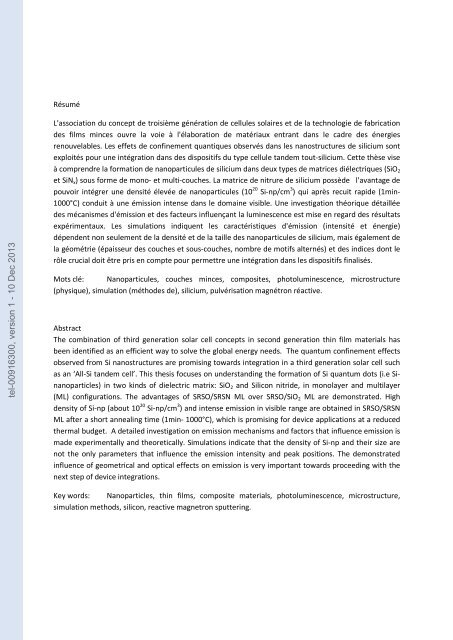Films minces à base de Si nanostructuré pour des cellules ...
Films minces à base de Si nanostructuré pour des cellules ...
Films minces à base de Si nanostructuré pour des cellules ...
You also want an ePaper? Increase the reach of your titles
YUMPU automatically turns print PDFs into web optimized ePapers that Google loves.
Résumé<br />
tel-00916300, version 1 - 10 Dec 2013<br />
L'association du concept <strong>de</strong> troisième génération <strong>de</strong> <strong>cellules</strong> solaires et <strong>de</strong> la technologie <strong>de</strong> fabrication<br />
<strong>de</strong>s films <strong>minces</strong> ouvre la voie <strong>à</strong> l'élaboration <strong>de</strong> matériaux entrant dans le cadre <strong>de</strong>s énergies<br />
renouvelables. Les effets <strong>de</strong> confinement quantiques observés dans les nanostructures <strong>de</strong> silicium sont<br />
exploités <strong>pour</strong> une intégration dans <strong>de</strong>s dispositifs du type cellule tan<strong>de</strong>m tout-silicium. Cette thèse vise<br />
<strong>à</strong> comprendre la formation <strong>de</strong> nanoparticules <strong>de</strong> silicium dans <strong>de</strong>ux types <strong>de</strong> matrices diélectriques (<strong>Si</strong>O 2<br />
et <strong>Si</strong>N x ) sous forme <strong>de</strong> mono- et multi-couches. La matrice <strong>de</strong> nitrure <strong>de</strong> silicium possè<strong>de</strong> l'avantage <strong>de</strong><br />
pouvoir intégrer une <strong>de</strong>nsité élevée <strong>de</strong> nanoparticules (10 20 <strong>Si</strong>-np/cm 3 ) qui après recuit rapi<strong>de</strong> (1min-<br />
1000°C) conduit <strong>à</strong> une émission intense dans le domaine visible. Une investigation théorique détaillée<br />
<strong>de</strong>s mécanismes d'émission et <strong>de</strong>s facteurs influençant la luminescence est mise en regard <strong>de</strong>s résultats<br />
expérimentaux. Les simulations indiquent les caractéristiques d'émission (intensité et énergie)<br />
dépen<strong>de</strong>nt non seulement <strong>de</strong> la <strong>de</strong>nsité et <strong>de</strong> la taille <strong>de</strong>s nanoparticules <strong>de</strong> silicium, mais également <strong>de</strong><br />
la géométrie (épaisseur <strong>de</strong>s couches et sous-couches, nombre <strong>de</strong> motifs alternés) et <strong>de</strong>s indices dont le<br />
rôle crucial doit être pris en compte <strong>pour</strong> permettre une intégration dans les dispositifs finalisés.<br />
Mots clé: Nanoparticules, couches <strong>minces</strong>, composites, photoluminescence, microstructure<br />
(physique), simulation (métho<strong>de</strong>s <strong>de</strong>), silicium, pulvérisation magnétron réactive.<br />
Abstract<br />
The combination of third generation solar cell concepts in second generation thin film materials has<br />
been i<strong>de</strong>ntified as an efficient way to solve the global energy needs. The quantum confinement effects<br />
observed from <strong>Si</strong> nanostructures are promising towards integration in a third generation solar cell such<br />
as an ‘All-<strong>Si</strong> tan<strong>de</strong>m cell’. This thesis focuses on un<strong>de</strong>rstanding the formation of <strong>Si</strong> quantum dots (i.e <strong>Si</strong>nanoparticles)<br />
in two kinds of dielectric matrix: <strong>Si</strong>O 2 and <strong>Si</strong>licon nitri<strong>de</strong>, in monolayer and multilayer<br />
(ML) configurations. The advantages of SRSO/SRSN ML over SRSO/<strong>Si</strong>O 2 ML are <strong>de</strong>monstrated. High<br />
<strong>de</strong>nsity of <strong>Si</strong>-np (about 10 20 <strong>Si</strong>-np/cm 3 ) and intense emission in visible range are obtained in SRSO/SRSN<br />
ML after a short annealing time (1min- 1000°C), which is promising for <strong>de</strong>vice applications at a reduced<br />
thermal budget. A <strong>de</strong>tailed investigation on emission mechanisms and factors that influence emission is<br />
ma<strong>de</strong> experimentally and theoretically. <strong>Si</strong>mulations indicate that the <strong>de</strong>nsity of <strong>Si</strong>-np and their size are<br />
not the only parameters that influence the emission intensity and peak positions. The <strong>de</strong>monstrated<br />
influence of geometrical and optical effects on emission is very important towards proceeding with the<br />
next step of <strong>de</strong>vice integrations.<br />
Key words: Nanoparticles, thin films, composite materials, photoluminescence, microstructure,<br />
simulation methods, silicon, reactive magnetron sputtering.
















